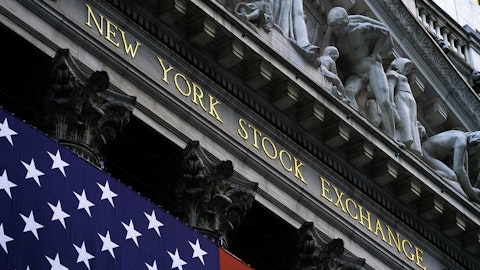In this article, we discuss the 12 lowest PE ratio S&P 500 stocks.
The S&P 500 headed into September 2025 following robust gains, yet investor sentiment was mixed since it is a month that has historically been weak for equities. September has been the worst-performing month over the past decade, with an average return of about -2%, and the index fell in six of the last ten Septembers.
Despite potential near-term volatility, UBS analysts suggest that investors who have less exposure to stocks should consider incrementally raising it and using market dips as buying opportunities. UBS expects the S&P 500 to reach 6,800 by the end of June 2026, around 5% higher, based on several factors. Most companies in the S&P 500 have reported Q2 2025 earnings, with 81% beating Wall Street expectations, while third-quarter guidance is also favorable.
Similarly, top brokerages are feeling more optimistic about the S&P 500, pointing to strong corporate earnings and a stable American economy, even though some companies warn about the harrowing impacts of tariffs. The difference between positive broker targets and cautious company signals means the market may depend on how well businesses handle these tariffs.
With that outlook in mind, let’s take a look at the S&P 500 stocks with a low PE ratio.

Photo by Pascal Bernardon on Unsplash
Our Methodology
For this article, a stock screener was used to identify S&P 500 companies. The stocks were then sorted by ascending P/E ratios, and the 12 with the lowest ratios as of September 30 were chosen. Additionally, hedge fund sentiment for these holdings from the June quarter is included to provide further context. The list is ranked according to hedge fund data, from lowest to highest.
Why are we interested in the stocks that hedge funds pile into? The reason is simple: our research has shown that we can outperform the market by imitating the top stock picks of the best hedge funds. Our quarterly newsletter’s strategy selects 14 small-cap and large-cap stocks every quarter and has returned 373.4% since May 2014, beating its benchmark by 218 percentage points (see more details here).
12. APA Corporation (NASDAQ:APA)
Number of Hedge Fund Holders: 33
PE Ratio as of September 30: 8.30
APA Corporation (NASDAQ:APA) is a Texas-based energy company that explores, develops, and sells natural gas, crude oil, and natural gas liquids. It operates oil and gas projects in the United States, Egypt, and the North Sea.
During the second quarter of 2025, APA started cutting its Permian rig count from eight to six, showing improvements in drilling efficiency. The company now expects to keep oil production in the Permian steady at six rigs, down from the 6.5 rigs planned in May. Better capital efficiency in the Permian has lessened the original capital forecast by $130 million, while keeping the same oil production targets, after adjusting for the disposal of the New Mexico asset in mid-June.
In addition to being one of the S&P 500 stocks with a low P/E ratio, APA provides a steady stream of dividend payouts to its investors. The company has issued cash dividends on its common stock since 1965. On September 9, APA Corporation (NASDAQ:APA) declared a quarterly dividend of $0.25 per share, which is distributable on November 21 to shareholders listed as of October 22. During the June quarter, the company returned $140 million to shareholders through its standard dividend and stock repurchase initiatives. It has a dividend yield of 4.05% as of September 30.
11. Conagra Brands, Inc. (NYSE:CAG)
Number of Hedge Fund Holders: 38
PE Ratio as of September 30: 7.56
Conagra Brands, Inc. (NYSE:CAG) is one of the S&P 500 stocks with a low PE ratio. On September 24, Evercore ISI reiterated an In Line rating on CAG while slashing the target price from $24 to $23.
Evercore lowered its price target following a drop in its FY2026 EPS from $1.82 to $1.79, reflecting a 22% year-over-year dip. The firm pointed to higher commodity inflation, particularly in beef, as the main factor leading to the downward revision.
The research firm mentioned that fiscal year 2026 is another year of change for Conagra, pointing towards challenges such as rising expenses, potential tariffs, impacts from divesting brands, and investments in price and promotion strategies.
According to Evercore ISI, it will wait to see if Conagra can regain organic sales growth heading into FY 2027, with a spotlight on the Frozen and Snacks segments, which contribute to roughly two-thirds of sales.
The $23 price target equals 12 times the firm’s projected 2027 EPS, indicating a slight discount compared with Conagra’s five-year average PE ratio of 13x, which has ranged from 10x to 16x.
Conagra Brands, Inc. (NYSE:CAG) is an American food company that sells packaged consumer products. It has four main segments: Grocery & Snacks, Refrigerated & Frozen, International, and Foodservice.
10. Molson Coors Beverage Company (NYSE:TAP)
Number of Hedge Fund Holders: 37
PE Ratio as of September 30: 8.63
Molson Coors Beverage Company (NYSE:TAP) ranks 10th on our list of the S&P 500 stocks with a low PE ratio. Molson Coors makes and sells beer and other malt drinks around the world, including hard seltzers, craft beers, spirits, and ready-to-drink beverages.
On September 30, Piper Sandler maintained a Neutral rating on TAP and trimmed the price target from $53 to $52. The research firm pointed to current challenges and a lack of immediate growth stimulators, aside from a potential boost in American consumer spending, which has not yet materialized.
The new price target equals a PE ratio of about 9x, topping the five-year historical average of 7.6x as well as the current figure. Despite the difficult environment, the company maintains a 4.11% dividend yield and a 51-year track record of dividend payouts
Piper Sandlet also highlighted ongoing pressure on revenue growth in both the United States and EMEA markets, which it expects to continue in the near term. The firm revised its Q3 2025 Americas organic sales decline forecast down by about 1% to align with the current retail environment.
Even though on-premise sales might be picking up pace, Molson Coors’ overall volumes are expected to stay under pressure at least until 2026. Due to this, Piper Sandler lowered its EPS estimates, cutting the 2025 and 2026 forecasts to $5.43 and $5.75, respectively, which resulted in a lower price target.





